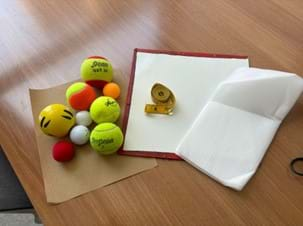Materials List:
Drop the Ball:
Learning About Material Physics, Motion, and Quadratics Through Sport Design
 https://www.teachengineering.org/activities/view/uot-2980-drop-ball-material-physics-motion-quadratics
https://www.teachengineering.org/activities/view/uot-2980-drop-ball-material-physics-motion-quadratics
Learning About Material Physics, Motion, and Quadratics Through Sport Design
Each student needs:
- 1 Project Packet (contains all the worksheets needed to complete the project)
- 1 Feedback Form (used for the playtest portion of the activity)
- optional: access to Google Sheets or Microsoft Excel for plotting graphs (Data collected can be entered in Excel Graphs Sheet and the sheet will generate position-time graphs in forms of parabolas from the drop to first bounce, between first and second bounce, and between second and third bounce.)
- optional: plotting calculator (not necessary for the learning goals)
Each group needs:
- 1 laptop/tablet
- 1 graphing calculator (or a computer with access to Desmos)
- 1 meter stick or tape measure (use big font tape measures)
- 1 phone or camera (for slow-motion camera)
- (optional) 1 motion detector
For the class to share:
- laptop or computer with Internet access and a projector (to show YouTube videos)
- access to the following videos, which help students understand the engineering involved in designing sports and athletic equipment:
- Sports engineering video (6:45 minutes): https://www.youtube.com/watch?v=2xJ3q3q1i4c
- Unique sports video (9:46 minutes): https://www.youtube.com/watch?v=K4FAs95PM4s
- Tennis Lab (3:36 minutes): https://www.youtube.com/watch?v=9lQy78zAlFc
- Wilson “airless” basketball (0:55 minutes): https://www.youtube.com/shorts/7Lsk8qiZ7pE
- base and ball materials: A variety of base and ball materials should be provided for the class. Below is a list of possible materials with links to purchase and approximate prices for a class of 30 students. We recommend seeing what you have in the classroom, in your athletics department or at home before making any purchases. Most of these are common materials and don’t need to be purchased!

- Possible surface materials:
- rubber mats
- whiteboards: class set of minis OR several large whiteboards
- Styrofoam OR craft foam sheets
- sandpaper
- foam pad
- plastic folders
- clear sheet protectors
- card stock
- artificial grass mat
- fabric mesh
- garden net
- embroidery hoop
- Possible types of balls:
 https://www.teachengineering.org/activities/view/uot-2980-drop-ball-material-physics-motion-quadratics
https://www.teachengineering.org/activities/view/uot-2980-drop-ball-material-physics-motion-quadratics